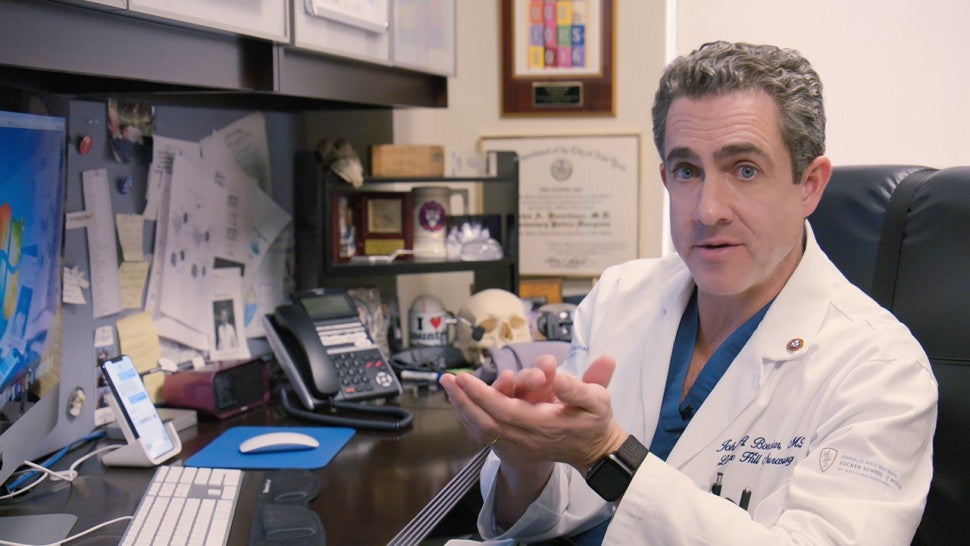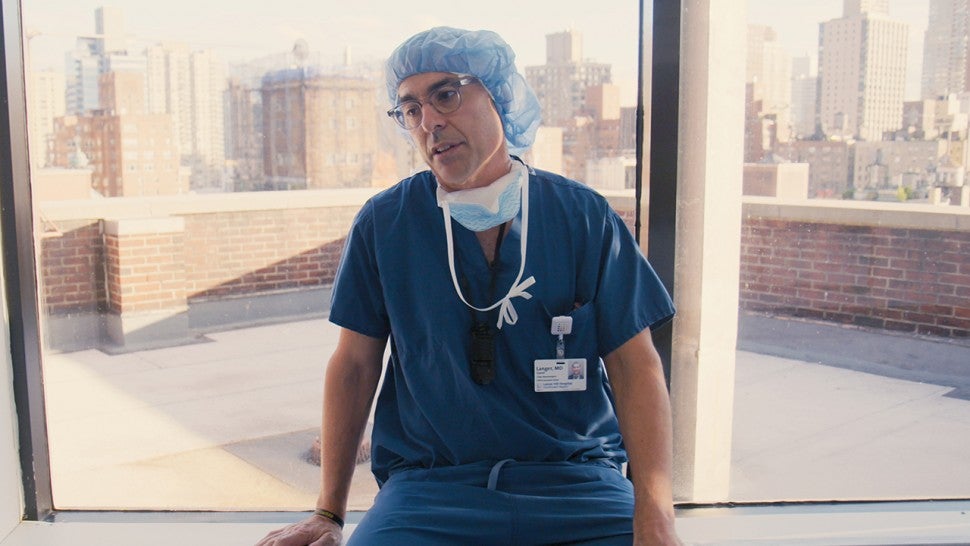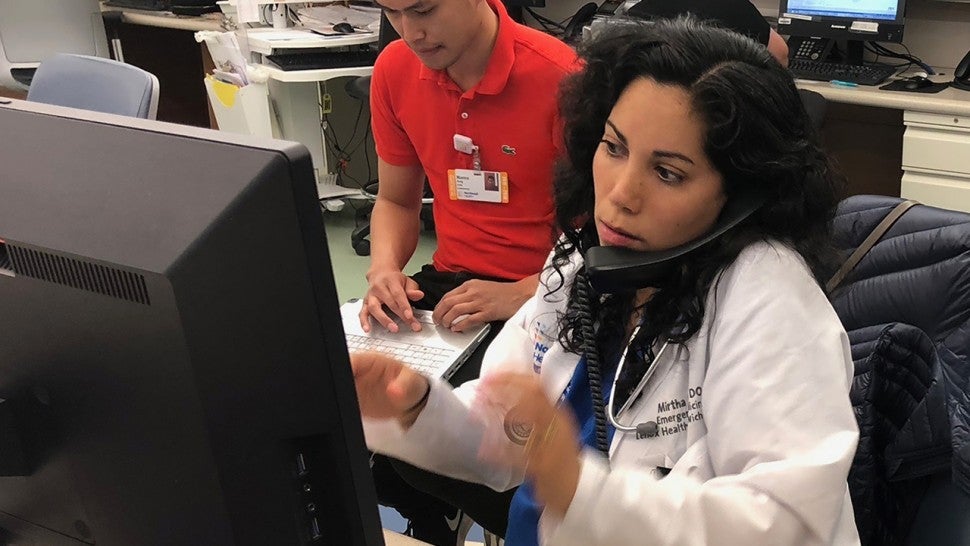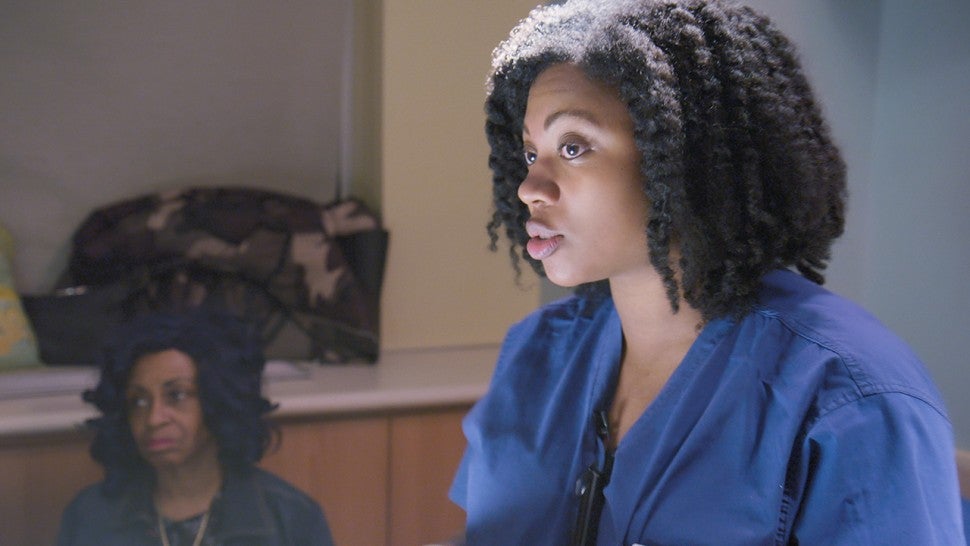Lenox Hill is the powerful new docuseries from filmmakers Adi Barash and Ruthie Shatz that provides audiences with a rare and deeply personal look at the lives of healthcare professionals and their patients at a New York City-area hospital.
Filmed from April 2018 to November 2019, just before the coronavirus outbreak, the eight-part series follows brain surgeons David Langer and John Boockvar, emergency room physician Mirtha Macri and Chief Resident OB/GYN Amanda Little-Richardson as they navigate the ups and downs of patient care and try to maintain a balance between their personal and professional lives.
“There’s so much emotional energy that goes into doing this,” Dr. Langer, chair of the neurosurgery department, says at one point in the series, which has been dubbed the real-life Grey’s Anatomy. But this isn’t scripted -- this is real life. Now streaming on Netflix, Dr. Boockvar, Dr. Langer, Dr. Little-Richardson and Dr. Macri spoke to ET about those comparisons to the long-running medical drama, what they went through amid the COVID-19 pandemic and what they hope audiences will get out of watching.
Recommended Videos
Those Comparisons to Grey’s Anatomy
When the series was first announced, many people -- including ET -- dubbed it the real-life Grey’s Anatomy (or ER) due to its mix of passionate doctors, sympathetic patients and tear-induced storytelling. And then, as the series showed, there were some uncanny overlap between both worlds, whether it was a focus on neurosurgery and Dr. Boockvar’s medical study on brain cancer, or Dr. Little-Richardson and Dr. Macri’s ongoing pregnancies while working, or seeing one of their own face down cancer.
“It’s similar in that medicine is stressful,” says Dr. Little-Richardson, who finds the comparisons a compliment. She adds that early on, Grey’s Anatomy captured the physically draining aspects of residency. “We do a lot of the same procedures that they showed,” Dr. Boockvar says of taking out brain tumors or helping patients battle Parkinson's disease.
While the doctors ultimately don’t mind the inevitable comparisons, they do clarify that all the drama that happens on those primetime series does not happen in the halls -- or more specifically, the elevators -- of their hospital. “Of course, we hope we don't have sultry relationships,” Dr. Boockvar says.
“The show was obviously unrealistic in a lot of ways, but it made it a valiant attempt to sort of be on the inside,” he continues, explaining he has four teenage kids who have kept up with the series over the years and still watch what happens at Seattle Grace Hospital. “Obviously we don't have patients with bombs inside of them. There’s lots of histrionic stories.”

“They’re actually pretty accurate or more accurate in the beginning, but then the medical stories kind of veer into craziness or lunacy because it's the people and the relationships that underlie the show’s success,” adds Dr. Langer, who reveals that he once took his daughter to visit the Grey’s set and got to meet Meredith herself, Ellen Pompeo.
Aside from the lack of soapy, primetime drama, they all mention that in real life, there’s more focus on patient care. “Our experience on the show was more patient-centered,” Dr. Macri specifically says of what’s seen on Lenox Hill.
“We definitely value patient confidentiality and patient choice,” Dr. Little-Richardson adds. “We don't do any procedures that a patient doesn't consent to.”
Ultimately, “what a fictional show can do is it can color the edges of the things that we can't do in real life,” Dr. Langer says of the power of these scripted dramas. “And maybe the next medical show will use some of the lessons of [Lenox Hill], and allow the reality of what's happening to be fictionalized in a better way.”
What Life Has Been Like Amid the Coronavirus Outbreak
The series notably concluded in November 2019, just months before the COVID-19 outbreak would change life all around the country and put the U.S. healthcare system to the ultimate test. In the early months of the outbreak, New York City became one of the major epicenters of the pandemic.
For Dr. Boockvar, the one way to describe it is comparing it to what happens amid a natural disaster. “If you had a really good town or city that was destroyed by a hurricane and everyone survived, then you rebuilt the town and made it even better than before,” he says. “That's what's happened in our hospitals.”
“It was terrifying at first, but then gratifying later on,” says Dr. Langer, who also spent time at the makeshift hospital erected in Manhattan’s Javits Center. “I think the terrifying part was when I didn't know what to do. But once I figured out what we and our team should do and then initiated those changes is when it became gratifying.”

Dr. Langer adds, “I learned about myself. We learned about our team. We learned about chaos, how to manage yourself in chaos, how chaos breeds. I feel really lucky to have gone through what we went through, I'm not gonna lie to you.”
Returning to work in the emergency room was a bit more stressful for Dr. Macri, who is now expecting her second child. Being pregnant while working added some pressure, she admits. “It was basically everyone on deck,” she says, adding there “was a systematic planning of how we're going to see these patients, how we're going to protect ourselves. And that was the most important aspect of the entire process… There was a lot of anxiety around that.”
While her experience was largely positive, she does admit that morale struggled at times, especially when staff members got sick. “We were overwhelmed,” she says. “But throughout it all, it took a lot of teamwork and effort to maintain things… We did an amazing job.”

Dr. Little-Richardson, who moved to California after filming was completed, says the OB department where she now works was lucky to have younger, healthier patients who weren’t as high-risk. “We’re taking extra precautions,” she says, adding that she has so much respect for her colleagues who have been the primary caretakers of COVID-19 patients.
“The pandemic combined with the protests has just been unbelievable,” Dr. Langer says. “I feel so blessed to be in healthcare right now.”
What the Doctors Hope Audiences Get Out of Watching Lenox Hill
When it comes to what was captured onscreen, everyone says it was all accurate -- and it was also a great way to show what life is really like inside a hospital. “I actually thought it was amazing that they captured an actual view of what it was like to be in a patient's exam room, to be at the nurses’ station,” Dr. Macri says, joking that she “certainly was concerned about, you know, whatever came out of my mouth.”
In one of the more tense developments that played out on the show, one of the neurosurgeons -- Dr. Mitch Levine -- was diagnosed with cancer. And part of his battle played out in front of the cameras. Dr. Langer says it wasn’t an easy decision, but felt that it would be beneficial to audiences to see someone like him go through this experience. “Showing a patient story that was so close to home would be valuable for cancer survivors and cancer patients,” he says.
For Dr. Little-Richardson, Lenox Hill was a chance to show what pregnancy and labor is really like -- and show so many people who haven’t experienced what it’s like. “Many people did feel like they got an up close and personal [look] at labor and the delivery experience,” she says, adding that many people “only see what's been sensationalized on television and in the movies, where people are just screaming and everything is chaotic. Sometimes it is like that. But other times there's a peace that’s present at delivery and it can be a really magical, beautiful experience.”

And when it comes to giving birth on camera, Dr. Macri says the whole experience was “really beautiful.” She adds, “After, I actually saw the footage and I just loved it. I loved seeing my son being born.”
She wasn’t the only one to get emotional by the footage. “I was choked up many times when watching the show, just thinking about how I got here and how beautiful things are in my life right now and how grateful I am to be able to share this experience with everybody else,” Dr. Boockvar says of his time on the show, adding that “the whole experience, for me, was very introspective.”
Ultimately for the neurosurgeon, he saw being on Lenox Hill as a way to possibly create somebody other than an Instagram influencer for young people to look up to. “It’s very hard to really depict what the life of a nurse is like, or what being a surgeon or a doctor is like,” he says. “So when I think about the opportunity to really contribute meaningfully to the establishment of role models for the youth of America, particularly in this day and age, across all races and sexes, it's an incredible opportunity to do that [with Lenox Hill]. That's what I'm really proud of.”
Dr. Langer, who largely did this for his kids, also saw the docuseries as an opportunity to tell their story and hopefully inspire young people who may be watching it. “Seeing who our children now look to as their heroes and their mentors, over the years, I began to question why healthcare doesn't do a better job of expressing itself,” he says, explaining that there’s been a drop-off of children interested in science and healthcare. “Whether it's a doctor, nurse, or healthcare administrator, we need some of our best and brightest to continue to push themselves and do this.”
RELATED CONTENT:
'Lenox Hill' Trailer: Netflix Docuseries Captures Life Inside a NYC Hospital Before Coronavirus
'Grey's Anatomy,' 'Station 19' and Other Medical Dramas Donate Supplies Amid Coronavirus Outbreak
'Grey's Anatomy' to End Season 16 Early Due to Coronavirus Shutdown